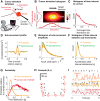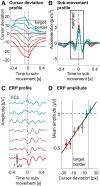Action Monitoring Cortical Activity Coupled to Submovements
- PMID: 29071301
- PMCID: PMC5654239
- DOI: 10.1523/ENEURO.0241-17.2017
Action Monitoring Cortical Activity Coupled to Submovements
Abstract
Numerous studies have examined neural correlates of the human brain's action-monitoring system during experimentally segmented tasks. However, it remains unknown how such a system operates during continuous motor output when no experimental time marker is available (such as button presses or stimulus onset). We set out to investigate the electrophysiological correlates of action monitoring when hand position has to be repeatedly monitored and corrected. For this, we recorded high-density electroencephalography (EEG) during a visuomotor tracking task during which participants had to follow a target with the mouse cursor along a visible trajectory. By decomposing hand kinematics into naturally occurring periodic submovements, we found an event-related potential (ERP) time-locked to these submovements and localized in a sensorimotor cortical network comprising the supplementary motor area (SMA) and the precentral gyrus. Critically, the amplitude of the ERP correlated with the deviation of the cursor, 110 ms before the submovement. Control analyses showed that this correlation was truly due to the cursor deviation and not to differences in submovement kinematics or to the visual content of the task. The ERP closely resembled those found in response to mismatch events in typical cognitive neuroscience experiments. Our results demonstrate the existence of a cortical process in the SMA, evaluating hand position in synchrony with submovements. These findings suggest a functional role of submovements in a sensorimotor loop of periodic monitoring and correction and generalize previous results from the field of action monitoring to cases where action has to be repeatedly monitored.
Keywords: EEG; error; kinematics; monitoring; submovements; supplementary motor area.
Figures







Similar articles
-
Spatiotemporal dynamics of online motor correction processing revealed by high-density electroencephalography.J Cogn Neurosci. 2014 Sep;26(9):1966-80. doi: 10.1162/jocn_a_00593. Epub 2014 Feb 24. J Cogn Neurosci. 2014. PMID: 24564462 Free PMC article.
-
ERP correlates of linear hand movements: distance dependent changes.Clin Neurophysiol. 2010 Aug;121(8):1285-92. doi: 10.1016/j.clinph.2010.02.151. Epub 2010 Mar 15. Clin Neurophysiol. 2010. PMID: 20227915
-
Reconstructing three-dimensional hand movements from noninvasive electroencephalographic signals.J Neurosci. 2010 Mar 3;30(9):3432-7. doi: 10.1523/JNEUROSCI.6107-09.2010. J Neurosci. 2010. PMID: 20203202 Free PMC article.
-
A Brief History of the Encoding of Hand Position by the Cerebral Cortex: Implications for Motor Control and Cognition.Cereb Cortex. 2019 Feb 1;29(2):716-731. doi: 10.1093/cercor/bhx354. Cereb Cortex. 2019. PMID: 29373634 Review.
-
Movement control. Moving the mental maps.Curr Biol. 1995 Oct 1;5(10):1082-4. doi: 10.1016/s0960-9822(95)00215-6. Curr Biol. 1995. PMID: 8548271 Review.
Cited by
-
Correlation of neural activity with behavioral kinematics reveals distinct sensory encoding and evidence accumulation processes during active tactile sensing.Neuroimage. 2018 Jul 15;175:12-21. doi: 10.1016/j.neuroimage.2018.03.035. Epub 2018 Mar 23. Neuroimage. 2018. PMID: 29580968 Free PMC article.
-
Inferring individual evaluation criteria for reaching trajectories with obstacle avoidance from EEG signals.Sci Rep. 2023 Nov 17;13(1):20163. doi: 10.1038/s41598-023-47136-2. Sci Rep. 2023. PMID: 37978205 Free PMC article.
-
Submovements in manual tracking: people with Parkinson's disease produce more submovements than age-matched controls.J Neuroeng Rehabil. 2025 Mar 6;22(1):51. doi: 10.1186/s12984-025-01592-1. J Neuroeng Rehabil. 2025. PMID: 40050876 Free PMC article.
-
Preserved electrophysiological markers of confidence in schizophrenia spectrum disorder.Schizophrenia (Heidelb). 2023 Feb 23;9(1):12. doi: 10.1038/s41537-023-00333-4. Schizophrenia (Heidelb). 2023. PMID: 36823178 Free PMC article.
-
Cortical responses to whole-body balance perturbations index perturbation magnitude and predict reactive stepping behavior.Eur J Neurosci. 2021 Dec;54(12):8120-8138. doi: 10.1111/ejn.14972. Epub 2020 Sep 20. Eur J Neurosci. 2021. PMID: 32931066 Free PMC article.
References
Publication types
MeSH terms
LinkOut - more resources
Full Text Sources
Other Literature Sources
